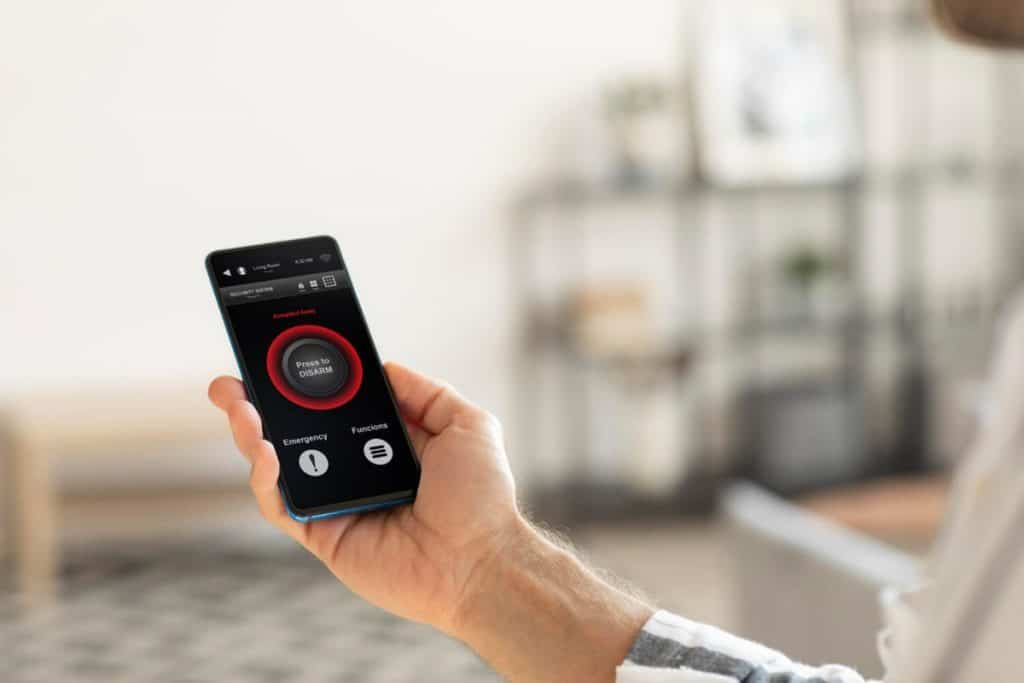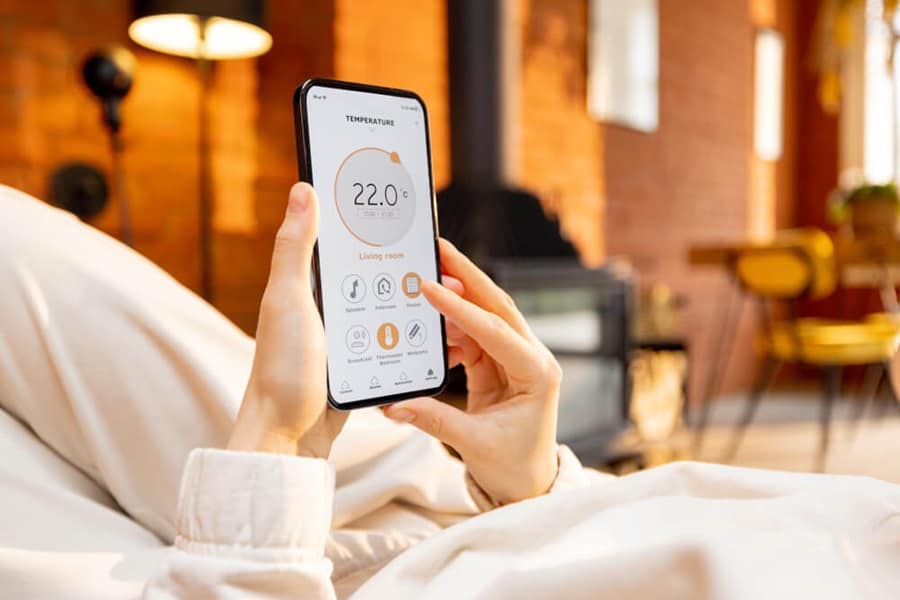
As our homes become more advanced and integrated with technology, so do the ways we manage our comfort – here is how to control underfloor heating from your phone.
Dial thermostats are dying out, and simpler innovations have evolved the world of smart heating solutions. Therefore, in this article, you will learn about how to control underfloor heating from your phone, as well as other forms of central heating systems. Discover the benefits, equipment needed, and expert advice on how you can easily integrate smartphone technology with your central heating methods in order to easily heat your home.
Why Control Underfloor Heating From Your Phone?
The majority of heating systems today mainly have programmable digital thermostats, with some even having multi zone underfloor heating capabilities. These advanced thermostats can fine-tune heating at different temperatures and schedules for each zone throughout the day, offering precision beyond the simple on/off functions of a standard thermostat.
Smartphones have also brought extra benefits to digital thermostats too, since you can now control your home heating systems directly from your mobile device. Not only does this method make heating your home a lot easier than having to be present in order to alter a dial, but you can also connect your heating to different systems around your home. With smartphone controls, you can make adjustments or turn off the heating from anywhere with a 3G, 4G, or Wi-Fi connection. No more wasted energy or money.
Most app controlled thermostats offer insightful charts and graphs that provide a visual representation of when and where your heating system is most active, helping you to make better decisions about your heating schedules both when in and out of your home. You can also learn more here by knowing how to take a meter reading here.
Ways On How To Control Underfloor Heating From Your Phone

Now that you understand the significant advantages of controlling your heating from your phone, you should also know the ways of how to control heating from your phone.
1. Equipment Needed
Firstly, you will undeniably need a thermostat, since this is the device that mainly monitors and controls the heat distribution across your home. These underfloor heating thermostats come in various types, with some being entirely wireless and suitable for installation almost anywhere within your property. Many features include touch screen interfaces that will feel familiar to regular smartphone users.
When considering smart thermostats, you’ll encounter several established brands, each with its own set of attributes. Most of the major players offer dedicated smartphone apps for remote control, adding an extra layer of versatility to your heating system. Such smartphone heating apps include:
- Nest
- Hive
- Honeywell
- Drayton
- Tado.
2. Which Heating System Works Best?
While smart thermostats can work with most heating setups, certain heating systems will work better with technology than others. If you’ve recently purchased an underfloor heating system, you can also control these with your mobile device easily.
All you need to do is check whether your underfloor heating system is supported by a particular thermostat and app. Look for systems that cater to both water and electric underfloor heating.
However, if you have an older heating system, it may be less compatible with contemporary control hardware and software, which may require more effort during installation. If in doubt, you can contact us today so that we can help with any of your underfloor heating issues and solutions.
3. Getting Started
Now that you’re ready to learn about the benefits of smartphone-controlled heating, it’s time to plan your heating overhaul. The first step is to define your objectives. What do you aim to achieve with this upgrade? Do you simply want the ability to adjust temperature settings remotely, or do you desire a more comprehensive system that offers control over various aspects of your home’s climate? Underlining your objectives here will help you to make a more informed decision about this new project.
Next, take stock of your existing assets. Examine the type of heating system currently installed in your property. Count the number of thermostats you have in place and note their locations. Determine how many rooms you want to heat and the specific areas covered by the system.
If you’re starting with a blank canvas, which will be particularly helpful for new-build homes, the possibilities are virtually limitless. You could opt for a single-zone underfloor heating solution in one part of your house while relying on standard central heating for the rest; this is especially helpful when learning how to integrate wall heaters and pipe distances with underfloor heating. Additionally, you can choose the smart thermostat setup that best suits your needs.
However, if you’re looking to improve on an existing heating system, things become slightly more complicated, especially if you are looking to add underfloor heating in period properties. You’ll need to assess your current setup, evaluate its various components, and compare them to the minimum requirements and compatibility constraints of the smart technology you plan to implement. Depending on your circumstances, some modifications may be minor, while others might require bigger changes.
As mentioned, do not overlook other important considerations such as the age and structural layout of your property. Think about which rooms should take priority when making heating-related adjustments. For instance, placing a single thermostat in the master bedroom may not be the best choice if you spend most of your time in the living room.
Also, heat rises, so having underfloor heating layouts in your living rooms, kitchens, and wet rooms, are a better place to start. We also offer various guides that cater to installing underfloor heating to different flooring layouts, including timber floors, vinyl flooring, porcelain or ceramic, concrete floors, and more.
Benefits Of Controlling Heating Using Your Phone
Now that you’ve laid the groundwork for your smart heating system, let’s look at the benefits of underfloor heating controls and other heating systems using your smartphone.
Firstly, having greater control over your heating allows you to run your home heating system with maximum efficiency, minimising energy wastage, heat loss, and lowering your utility bills. Consider the common scenario of returning home and manually boosting the heating as you walk through the door.
Also, with smartphone control, you can instantly adjust schedules. Even if you are staying late at the office, all you need to do is do a few taps on your heating app and you can switch to manual mode, delaying your heating until you’re on your way home.
Another feature that we previously mentioned with smartphone-controlled heating also often includes features like Multi-Zone Control. This functionality allows you to regulate the temperature of different rooms individually. For instance, if you have a child, you can set the nursery to a safe temperature range of 16°C to 20°C to ensure your little one sleeps comfortably, while keeping your living space warmer at a later time.
Furthermore, the flexibility of schedule changes makes it even easier to heat your home using your smartphone. Imagine the temperature dropping significantly while you’re on vacation or when you need to work late for an important meeting. Smartphone control allows you to set schedules and make quick adjustments from anywhere in the world, preventing energy waste.
Additionally, an Eco Mode feature is perfect for those looking to reduce their carbon footprint. Smart thermostats equipped with Eco Mode can allow you to focus heating in more populated areas of your home than others. Here, your smart thermostat calculates the most economical way to heat your home while maintaining maximum efficiency.
Comfort Mode is another intelligent feature that has been integrated into mobile heating apps. These algorithms calculate the best time to activate your heating based on your home’s thermal characteristics. This ensures that rooms reach the desired temperatures by the scheduled start time.
Finally, when you’re away on holiday or experiencing an unexpected overnight stay elsewhere, the Away Mode feature can be used too. Your underfloor heating app can be set to Away Mode, instantly lowering all set points in your home to conserve energy.
Plus, if you feel like your smartphone is overheating, we have found a few reasons why this may be.
How To Control Underfloor Heating From Your Smartphone
In conclusion, the shift towards smartphone-controlled heating represents a dramatic shift in home comfort. Whilst many homeowners still prefer to use more basic thermostat models, for better convenience and optimisation, knowing how to control underfloor heating with your smartphone with operated heating thermostats are the way forward to better heat your home when the house is occupied, and at a time that suits you best so that you can conserve energy.
FAQs
Can I control my thermostat from my phone?
Yes, many modern thermostats offer smartphone control through dedicated apps.
Can I turn my heat on with my phone?
Yes, if your heating system is compatible and connected to a smartphone app, you can turn your heat on/off remotely.
Is there a phone app to turn on heating on?
Yes, there are various smartphone apps available for remotely controlling heating systems.
Can I connect my phone to my boiler?
Some boilers can be integrated with smart home systems or apps for remote control, but compatibility may vary depending on your boiler model and technology used.
Sources
Cawley, C., (2023) Why Your Android Phone Is Overheating (And How to Fix It). Make Use Of. [online] Available at: https://www.makeuseof.com/tag/prevent-android-phone-overheating/ [accessed 15/11/23]
